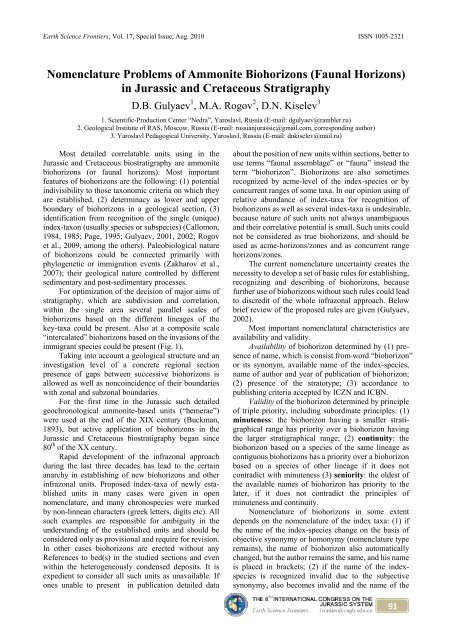in Jurassic and Cretaceous Stratigraphy
in Jurassic and Cretaceous Stratigraphy
in Jurassic and Cretaceous Stratigraphy
Create successful ePaper yourself
Turn your PDF publications into a flip-book with our unique Google optimized e-Paper software.
Earth Science Frontiers, Vol. 17, Special Issue, Aug. 2010 ISSN 1005-2321<br />
Nomenclature Problems of Ammonite Biohorizons (Faunal Horizons)<br />
<strong>in</strong> <strong>Jurassic</strong> <strong>and</strong> <strong>Cretaceous</strong> <strong>Stratigraphy</strong><br />
D.B. Gulyaev 1 , M.A. Rogov 2 , D.N. Kiselev 3<br />
1. Scientific-Production Center “Nedra”, Yaroslavl, Russia (E-mail: dgulyaev@rambler.ru)<br />
2. Geological Institute of RAS, Moscow, Russia (E-mail: russianjurassic@gmail.com, correspond<strong>in</strong>g author)<br />
3. Yaroslavl Pedagogical University, Yaroslavl, Russia (E-mail: dnkiselev@mail.ru)<br />
Most detailed correlatable units us<strong>in</strong>g <strong>in</strong> the<br />
<strong>Jurassic</strong> <strong>and</strong> <strong>Cretaceous</strong> biostratigraphy are ammonite<br />
biohorizons (or faunal horizons). Most important<br />
features of biohorizons are the follow<strong>in</strong>g: (1) potential<br />
<strong>in</strong>divisibility to those taxonomic criteria on which they<br />
are established, (2) determ<strong>in</strong>acy as lower <strong>and</strong> upper<br />
boundary of biohorizons <strong>in</strong> a geological section, (3)<br />
identification from recognition of the s<strong>in</strong>gle (unique)<br />
<strong>in</strong>dex-taxon (usually species or subspecies) (Callomon,<br />
1984, 1985; Page, 1995; Gulyaev, 2001, 2002; Rogov<br />
et al., 2009, among the others). Paleobiological nature<br />
of biohorizons could be connected primarily with<br />
phylogenetic or immigration events (Zakharov et al.,<br />
2007); their geological nature controlled by different<br />
sedimentary <strong>and</strong> post-sedimentary processes.<br />
For optimization of the decision of major aims of<br />
stratigraphy, which are subdivision <strong>and</strong> correlation,<br />
with<strong>in</strong> the s<strong>in</strong>gle area several parallel scales of<br />
biohorizons based on the different l<strong>in</strong>eages of the<br />
key-taxa could be present. Also at a composite scale<br />
“<strong>in</strong>tercalated” biohorizons based on the <strong>in</strong>vasions of the<br />
immigrant species could be present (Fig. 1).<br />
Tak<strong>in</strong>g <strong>in</strong>to account a geological structure <strong>and</strong> an<br />
<strong>in</strong>vestigation level of a concrete regional section<br />
presence of gaps between successive biohorizons is<br />
allowed as well as nonco<strong>in</strong>cidence of their boundaries<br />
with zonal <strong>and</strong> subzonal boundaries.<br />
For the first time <strong>in</strong> the <strong>Jurassic</strong> such detailed<br />
geochronological ammonite-based units (“hemerae”)<br />
were used at the end of the XIX century (Buckman,<br />
1893), but active application of biohorizons <strong>in</strong> the<br />
<strong>Jurassic</strong> <strong>and</strong> <strong>Cretaceous</strong> biostratigraphy began s<strong>in</strong>ce<br />
80 th of the XX century.<br />
Rapid development of the <strong>in</strong>frazonal approach<br />
dur<strong>in</strong>g the last three decades has lead to the certa<strong>in</strong><br />
anarchy <strong>in</strong> establish<strong>in</strong>g of new biohorizons <strong>and</strong> other<br />
<strong>in</strong>frazonal units. Proposed <strong>in</strong>dex-taxa of newly esta-<br />
blished units <strong>in</strong> many cases were given <strong>in</strong> open<br />
nomenclature, <strong>and</strong> many chronospecies were marked<br />
by non-l<strong>in</strong>nean characters (greek letters, digits etc). All<br />
such examples are responsible for ambiguity <strong>in</strong> the<br />
underst<strong>and</strong><strong>in</strong>g of the established units <strong>and</strong> should be<br />
considered only as provisional <strong>and</strong> require for revision.<br />
In other cases biohorizons are erected without any<br />
References to bed(s) <strong>in</strong> the studied sections <strong>and</strong> even<br />
with<strong>in</strong> the heterogeneously condensed deposits. It is<br />
expedient to consider all such units as unavailable. If<br />
ones unable to present <strong>in</strong> publication detailed data<br />
about the position of new units with<strong>in</strong> sections, better to<br />
use terms “faunal assemblage” or “fauna” <strong>in</strong>stead the<br />
term “biohorizon”. Biohorizons are also sometimes<br />
recognized by acme-level of the <strong>in</strong>dex-species or by<br />
concurrent ranges of some taxa. In our op<strong>in</strong>ion us<strong>in</strong>g of<br />
relative abundance of <strong>in</strong>dex-taxa for recognition of<br />
biohorizons as well as several <strong>in</strong>dex-taxa is undesirable,<br />
because nature of such units not always unambiguous<br />
<strong>and</strong> their correlative potential is small. Such units could<br />
not be considered as true biohorizons, <strong>and</strong> should be<br />
used as acme-horizons/zones <strong>and</strong> as concurrent range<br />
horizons/zones.<br />
The current nomenclature uncerta<strong>in</strong>ty creates the<br />
necessity to develop a set of basic rules for establish<strong>in</strong>g,<br />
recogniz<strong>in</strong>g <strong>and</strong> describ<strong>in</strong>g of biohorizons, because<br />
further use of biohorizons without such rules could lead<br />
to discredit of the whole <strong>in</strong>frazonal approach. Below<br />
brief review of the proposed rules are given (Gulyaev,<br />
2002).<br />
Most important nomenclatural characteristics are<br />
availability <strong>and</strong> validity.<br />
Availability of biohorizon determ<strong>in</strong>ed by (1) pre-<br />
sence of name, which is consist from word “biohorizon”<br />
or its synonym, available name of the <strong>in</strong>dex-species,<br />
name of author <strong>and</strong> year of publication of biohorizon;<br />
(2) presence of the stratotype; (3) accordance to<br />
publish<strong>in</strong>g criteria accepted by ICZN <strong>and</strong> ICBN.<br />
Validity of the biohorizon determ<strong>in</strong>ed by pr<strong>in</strong>ciple<br />
of triple priority, <strong>in</strong>clud<strong>in</strong>g subord<strong>in</strong>ate pr<strong>in</strong>ciples: (1)<br />
m<strong>in</strong>uteness: the biohorizon hav<strong>in</strong>g a smaller strati-<br />
graphical range has priority over a biohorizon hav<strong>in</strong>g<br />
the larger stratigraphical range; (2) cont<strong>in</strong>uity: the<br />
biohorizon based on a species of the same l<strong>in</strong>eage as<br />
contiguous biohorizons has a priority over a biohorizon<br />
based on a species of other l<strong>in</strong>eage if it does not<br />
contradict with m<strong>in</strong>uteness (3) seniority: the oldest of<br />
the available names of biohorizon has priority to the<br />
later, if it does not contradict the pr<strong>in</strong>ciples of<br />
m<strong>in</strong>uteness <strong>and</strong> cont<strong>in</strong>uity.<br />
Nomenclature of biohorizons <strong>in</strong> some extent<br />
depends on the nomenclature of the <strong>in</strong>dex taxa: (1) if<br />
the name of the <strong>in</strong>dex-species change on the basis of<br />
objective synonymy or homonymy (nomenclature type<br />
rema<strong>in</strong>s), the name of biohorizon also automatically<br />
changed, but the author rema<strong>in</strong>s the same, <strong>and</strong> his name<br />
is placed <strong>in</strong> brackets; (2) if the name of the <strong>in</strong>dex-<br />
species is recognized <strong>in</strong>valid due to the subjective<br />
synonymy, also becomes <strong>in</strong>valid <strong>and</strong> the name of the<br />
91

















